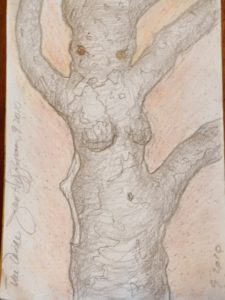The Need for Nuanced Conversations: About Wildfires.For Instance . by Joan Hoffman
The Need for Nuanced Conversations: About Wildfires.For Instance . by Joan Hoffman
Tree Dance/Nature
The advisability of a harmonious relationship with nature is often an implicit or explicit recommendation in the sustainability movement. However, nature, which did give birth to us, includes in its very structure characteristics which can obliterate humans in their path. Examples include earthquakes, volcanic eruptions, fierce storms and natural wildfires. The continents, the tectonic plates of the earth are engaged in a constant process of slipping away from under our feet and slamming into one another. Hence, when we are discussing cause and effects in our explorations of the environment, we must take the presence of these forces into account, as did the climate scientists who, knowing that the earth had carbon cycles, took care to measure just what kind of carbon was increasing so fast, and discovered that it had the structure of fossil fuels. (Cullen 2010)
For all of upcoming and increasingly difficult discussions which we shall be needing to have about climate change and how we address it, we need to be open to the influence of a multiplicity of causes and effects. We have a need for nuanced conversations that bring in all perspectives, for each perspective offers a different array of information. When we at first disagree with someone, we should say, “That is interesting. Why do you think so.” Of course, eventually probabilities will be assessed, weights will be assigned and decisions will be made. And, so will mistakes, but hopefully fewer with open minds and respect for the experience and knowledge of others. Wildfires offer an examples.
A BBC radio program was reporting on the claims that wildfires around the world were actually decreasing and that far too much was being made of them. This announcement and the ensuing discussion sent me on a wildfire exploration which proved yet again, the value of nuanced conversations. The factors which must be considered in this exploration are many. There is a data stream which shows a long term reduction in wildfires, but the data before 1990 is not considered reliable. Criteria and techniques have changed since then. Also, in fact area burned by wildfires have been on the rise. However, one reason for this is that because humans did not understand that nature used “spontaneous” wildfire as a natural tool, for instance for breaking open some seeds, humans had suppressed wildfires, producing an abundance of kindling, resulting in ever larger wildfires. Additionally, while global warming does produce conditions favorable to wildfires, most wildfires are started by humans, both intentionally and unintentionally. And the list of factors to consider goes on.
The three articles listed below can be a start to those who wish to explore the topic in more depth. However, the main lesson here is that we need to investigate all sources of information for its value, insights, and limitations. And with climate change, we shall be dealing with not only environmental factors but also the social and legal forces at work as people are pressured to move from areas that can no longer support them. These will be very difficult nuanced conversations, and we cannot expect them to be easy, but we shall learn more if we keep open minds.
Some Wildfire Discussion Sources
Gabbert, Bill. January 24, 2018. Visualizing California fires over the last 18 years
https://wildfiretoday.com/tag/statistics/
National Interagency Fire Center
https://www.nifc.gov/fireInfo/fireInfo_statistics.html
Environmental protection Agency : Climate Indicators
https://www.epa.gov/climate-indicators/climate-change-indicators-wildfires
Weather
Cullen H. 2010. The Weather of the Future.New York: Harper
